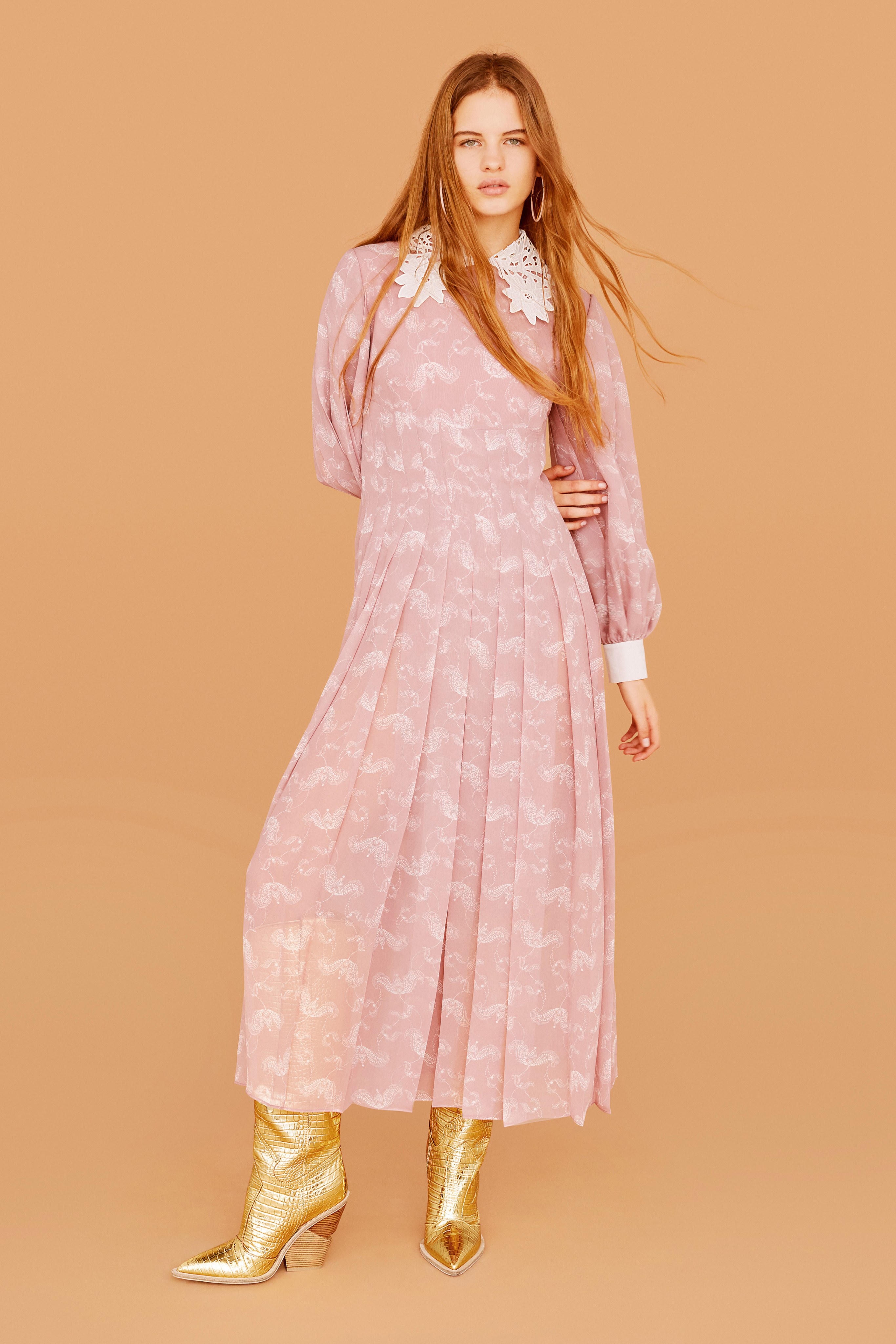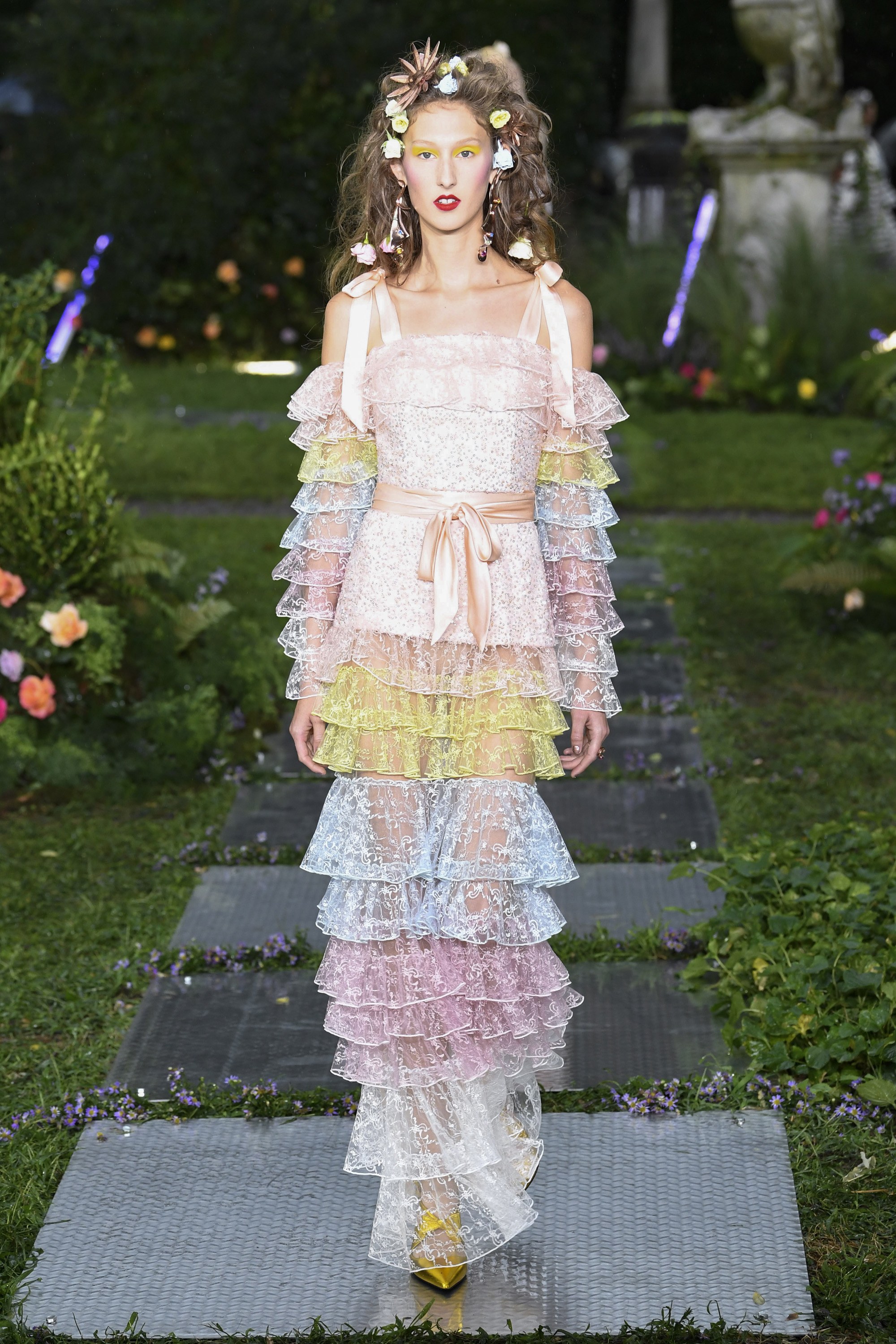2019 Forecast: Full-Fledged Feminine Fantasies
Androgynous fashion takes a break from the spotlight as femininity stands center stage once again.
With the bloom of a new year upon us, it is not surprising that we replay some of our throwback moments to commemorate the year prior. Perhaps nothing is more evident of this phenomenon than the official Pantone color of 2019–living coral. It’s an updated rehash of millenial pink from years’ past. According to executive director of the Pantone Institute, Leatrice Eiseman, living coral is meant to “energize and enliven with a softer edge”. Across 2019 showings and lookbooks, collections are saturated with feminine motifs, transitioning away from the need to prove androgyny is acceptable.
 The transition from androgynous fashion collections to traditionally feminine silhouettes and motifs moving forward is reflective of our sociopolitical landscape. This is encouraging: A need to no longer prove that bending gender-specific mindsets is necessary reflects a shift in societal perspective. Of course, there are designers whose hallmark has always nodded toward the permeable line between what is designated menswear and women-wear. Take Rei Kawakubo, founder of Comme des Garçons, who highlighted the 2017 MET Gala, in a seemingly final bid farewell to the androgynous focus from years’ past. But that feminine silhouettes, patterns, and color palettes are having a moment and both men and women are embracing the shift with the gusto of a debutante at a coming-out ball.
The transition from androgynous fashion collections to traditionally feminine silhouettes and motifs moving forward is reflective of our sociopolitical landscape. This is encouraging: A need to no longer prove that bending gender-specific mindsets is necessary reflects a shift in societal perspective. Of course, there are designers whose hallmark has always nodded toward the permeable line between what is designated menswear and women-wear. Take Rei Kawakubo, founder of Comme des Garçons, who highlighted the 2017 MET Gala, in a seemingly final bid farewell to the androgynous focus from years’ past. But that feminine silhouettes, patterns, and color palettes are having a moment and both men and women are embracing the shift with the gusto of a debutante at a coming-out ball.
Tory Burch Daily reported pink as the trend of the moment earlier this month. Interior designer, Madeleine Castaing, created a powder room – the woman’s equivalent to a man-cave- for the holiday 2018 editorial set. The room is covered in a floral vestal green and Concord grape blue wallpaper. A ruched pink silk covered vanity dressing table is perched against a wall paired with a plush pistachio pastel velvet stool. The gold-gilded mirror and chairs are ornately carved. The image appears on Burch’s Instagram, hash tagged #ToryBurchinColor. A couple of days later, the holiday editorial featured a bow-collared silk pink long-sleeve blouse and the new Robinson chain bag described as “super feminine.” And to complete the look is Tory Burch’s prized possession from the 80s – heart earrings, the light pink/coral color, considered “papaya” was sold out only a couple of weeks later.
Fendi’s resort 2019 collection championed a “a romantic femininity that addresses powerful, unique and hyper elegant women.” The design house said that the 2019 collections’ use of fur “injected a more feminine, opulent feel” than previous showings of what they considered “mannish tie-inspired graphic patterns.” Their Instagram emphasized this new take on feminine dress with lofty captions that included an image of a long floral-embellished overcoat with the caption, “unrivaled craftsmanship infused with a fresh, hyper-feminine feel. Next season starts now.” Another post was captioned, “a progressive take on feminine uniform dressing.” And another, “discover powerful, modern femininity with a Fendi twist.” The brand confirmed their 2018 transition from previous androgynous asymmetric patterns that had taken “a soft turn.” The handkerchief print from 2018 was replaced by floral patterns and the garments were lightened with “feather-weight shaved” mink coats embellished with pastel appliques.

Actress, Mandy Moore, recently got hitched in a custom-made ruffled and tiered pastel pink gown designed by Rodarte. The dress was tulle and included a floral brocade on the hip. Sister design-duo, Kate and Laura Mulleavy, have taken Rodarte to a botanical garden with no end in sight and even showcased their feminine collection at an exhibition funded by Women in the Arts, providing a customized playlist of songs by women musicians.
Make no mistake, traditionally patriarchal conceptions of womanhood like modesty, were nonexistent. Instead, a woman’s body – curves and reproductive anatomy – were highlighted across the board. Chloe’s creative director, Natacha Ramsay-Levi, whose take on “hippie modernism” was curated into the collection’s Femininities jewelry line; Necklaces with pendants of a headless, extremities-less, body – all curves that could be mistaken for an hourglass if not for engravings tracing anatomical secondary sex-characteristics. Mano Figaamulets, rarified Western, Catholicism-derived equivalents to the eastern Evil Eye, literally translates into what it is: clenched fists with the thumb sticking out from between the pointer and middle fingers in an obscene gesture meant to trump any outside obscenity with the intention of causing harm. The amulet is historically a symbol of feminine reproductive fertility and empowerment. Not surprisingly, in a tell-all interview of Ramsay-Levi earlier this year, stylist Camille Bidault-Waddington, her friend of 15 years, described Natacha’s design vision as “always the organic feminine.”

And women aren’t staying quiet about making their case for breaking through the feminist mystique. In the January 2019 issue of Vogue Australia, Emily Ratajkowski, who graced the cover in an outdoor bathtub, said she could not care less if her “wearing a crop top is somehow playing into some patriarchy, because it makes me feel good about myself.” She went on to say that defined guidelines for what a feminist should look like is “insane”. “No-one should be shaming anyone – women especially should not be shaming other women,” she went on to say.
If the pinkish Pantone color of the 2019 – living coral – signals anything to come in fashion, it’s that the feelings of vibrancy, intimacy, and connectedness, pertains to a women rediscovering her femininity. As a society, we may have move passed the idea that women can wear the pants, so to speak, but getting past the idea of wearing pink as a political statement, or committing social suicide by wearing it on a day other than Wednesday (a pop cultural reference to Mean Girls,) still remains to be seen. Serena Williams’ 2018 French Open ensembles – a skintight black bodysuit, a tutu, and a pink short-sleeve shirt – was considered offensive – it seems like not only are the tennis powers at be will ratify their dress code, but so too have fashion houses the world over.